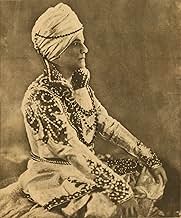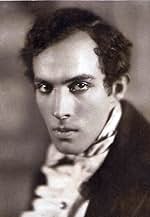After greedy men have Edmound Dantes unjustly imprisoned for 20 years for innocently delivering a letter entrusted to him, he escapes to get his revenge on themAfter greedy men have Edmound Dantes unjustly imprisoned for 20 years for innocently delivering a letter entrusted to him, he escapes to get his revenge on themAfter greedy men have Edmound Dantes unjustly imprisoned for 20 years for innocently delivering a letter entrusted to him, he escapes to get his revenge on them
Marie Glory
- Valentine de Villefort - la fille
- (as Mary Glory)
Storyline
Did you know
- TriviaLong thought lost, the film was gradually rediscovered in film archives around the world by former Variety critic Lenny Borger, and was restored under his supervision from 1999 to 2006 using four different prints and funding from the Franco-German channel Arte.
- ConnectionsVersion of The Count of Monte Cristo (1908)
Featured review
This is one of those pictures where I do find myself wondering what kind of audience they were originally anticipating (and, given the late release date, what sort of audience a two-part silent epic actually managed to garner in 1929). Presumably with a story as well-known as this one, a three-hour-plus running time wasn't felt to be a drawback when it came to getting the punters through the doors...
As for "Gone With the Wind", the BFI gave it a whole-afternoon screening treatment with an interval between the two halves; as with "Gone With the Wind", I felt that the first half was on balance the stronger film. (Any adaptation of Dumas' novel always has to contend with the book's rather unsatisfactory ending; either you change it, or you allow the film to drift off inconclusively. This one attempts both at once!)
As a retelling of Dumas' classic via the language of silent movies, Fescourt's "Monte Cristo" makes for a workmanlike and entertaining outcome (though I was amused by the way that the picture carefully avoids showing the actual figure of Napoleon Bonaparte, treating his brief scenes with the reverential avoidance generally shown for Jesus Christ). I was struck in particular by the extensive use of filming on location (including a brief scene at the Pont du Gard itself) and of genuine nineteenth-century sailing vessels, large and small; given the routine use of tanks and models in Hollywood movies both new and old, it was fascinating to me to see shots of ships that were obviously really sailing.
Jean Angelo (fifty-four when the film was released) and Lil Dagover (forty-two) are both really too old to portray the younger Edmond and Mercedes convincingly, although they undoubtedly have the acting chops to differentiate the two versions of the characters effectively and look very natural in the older roles. But it's interesting to see Edmond shown as a burly Marseilles sailor, rather than the romantic figure often adopted in later adaptations; one can really imagine this version as a capable first mate. And he is suitably implacable in the scenes of revenge -- though I felt that his "count-down" ("That makes one", "that makes two") didn't really work in a version of the plot where there are only two men left to dispose of in the first place.
Pierre Batcheff (as a handsome and sensitive Albert de Morcerf) and Robert Mérin (as a sullen teenage Benedetto far more dangerous than his adoptive father) stood out for me among the younger members of the cast, and Henri Debain does a good job of making his drunken Caderousse an almost sympathetic scoundrel. Meanwhile, Gaston Modot depicts Fernand's shift from jealous Catalan to soldier of fortune and then pompous retired officer with complete conviction.
I did think the film went a bit over the top in its use of flashbacks; it's as if they didn't trust us to remember what had happened a couple of hours earlier, and the result was that the same 'meaningful' bits of film ended up being shown three or four times, e.g. Haydee being dragged off to captivity. (It might have been less irritating so far as I was concerned if they'd managed to show different bits of illustrative footage for each flashback!) On the other hand, the film does a generally good job in condensing the plot of the book into a smaller timespan. I liked what they did to tie together the Benedetto and Caderousse material to make the boy significant from an earlier stage than in the book; I questioned, however, the enormous amount of detail and length they then devoted to some of the surviving subplots using the time saved...
There is some fine imagery in here (I'm assuming the Paris Opera interiors were not filmed on location, but the sets are very recognisable), although Monte Cristo's 'oriental' inhabitation in the caves comes across better when viewed as young Albert's fever dream than when we're supposed to take it literally in the finale. The sinister scenes in Caderousse's inn and the long shots down the weapons gallery come to mind as memorable; apparently the exterior scenes in the Château d'If actually were filmed there for real, which makes for impressive sun and sea vistas.
The film is definitely worth seeing. The version we saw had some slightly idiosyncratic English subtitles, which I would guess probably originated from a French-language translator rather than a native English-speaker, but they suffice. (Ideally you'd be reading the original French title cards, where the language is mostly pretty straightforward.)
As for "Gone With the Wind", the BFI gave it a whole-afternoon screening treatment with an interval between the two halves; as with "Gone With the Wind", I felt that the first half was on balance the stronger film. (Any adaptation of Dumas' novel always has to contend with the book's rather unsatisfactory ending; either you change it, or you allow the film to drift off inconclusively. This one attempts both at once!)
As a retelling of Dumas' classic via the language of silent movies, Fescourt's "Monte Cristo" makes for a workmanlike and entertaining outcome (though I was amused by the way that the picture carefully avoids showing the actual figure of Napoleon Bonaparte, treating his brief scenes with the reverential avoidance generally shown for Jesus Christ). I was struck in particular by the extensive use of filming on location (including a brief scene at the Pont du Gard itself) and of genuine nineteenth-century sailing vessels, large and small; given the routine use of tanks and models in Hollywood movies both new and old, it was fascinating to me to see shots of ships that were obviously really sailing.
Jean Angelo (fifty-four when the film was released) and Lil Dagover (forty-two) are both really too old to portray the younger Edmond and Mercedes convincingly, although they undoubtedly have the acting chops to differentiate the two versions of the characters effectively and look very natural in the older roles. But it's interesting to see Edmond shown as a burly Marseilles sailor, rather than the romantic figure often adopted in later adaptations; one can really imagine this version as a capable first mate. And he is suitably implacable in the scenes of revenge -- though I felt that his "count-down" ("That makes one", "that makes two") didn't really work in a version of the plot where there are only two men left to dispose of in the first place.
Pierre Batcheff (as a handsome and sensitive Albert de Morcerf) and Robert Mérin (as a sullen teenage Benedetto far more dangerous than his adoptive father) stood out for me among the younger members of the cast, and Henri Debain does a good job of making his drunken Caderousse an almost sympathetic scoundrel. Meanwhile, Gaston Modot depicts Fernand's shift from jealous Catalan to soldier of fortune and then pompous retired officer with complete conviction.
I did think the film went a bit over the top in its use of flashbacks; it's as if they didn't trust us to remember what had happened a couple of hours earlier, and the result was that the same 'meaningful' bits of film ended up being shown three or four times, e.g. Haydee being dragged off to captivity. (It might have been less irritating so far as I was concerned if they'd managed to show different bits of illustrative footage for each flashback!) On the other hand, the film does a generally good job in condensing the plot of the book into a smaller timespan. I liked what they did to tie together the Benedetto and Caderousse material to make the boy significant from an earlier stage than in the book; I questioned, however, the enormous amount of detail and length they then devoted to some of the surviving subplots using the time saved...
There is some fine imagery in here (I'm assuming the Paris Opera interiors were not filmed on location, but the sets are very recognisable), although Monte Cristo's 'oriental' inhabitation in the caves comes across better when viewed as young Albert's fever dream than when we're supposed to take it literally in the finale. The sinister scenes in Caderousse's inn and the long shots down the weapons gallery come to mind as memorable; apparently the exterior scenes in the Château d'If actually were filmed there for real, which makes for impressive sun and sea vistas.
The film is definitely worth seeing. The version we saw had some slightly idiosyncratic English subtitles, which I would guess probably originated from a French-language translator rather than a native English-speaker, but they suffice. (Ideally you'd be reading the original French title cards, where the language is mostly pretty straightforward.)
- Igenlode Wordsmith
- Jun 3, 2017
- Permalink
Details
- Release date
- Country of origin
- Languages
- Also known as
- Grof Monte Cristo
- Production companies
- See more company credits at IMDbPro
- Runtime3 hours 43 minutes
- Color
- Sound mix
- Aspect ratio
- 1.33 : 1
Contribute to this page
Suggest an edit or add missing content






















